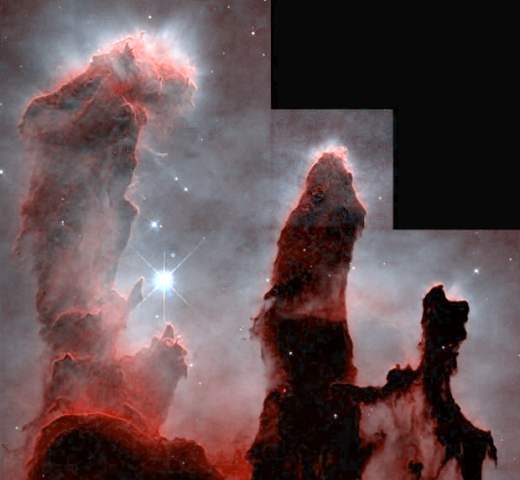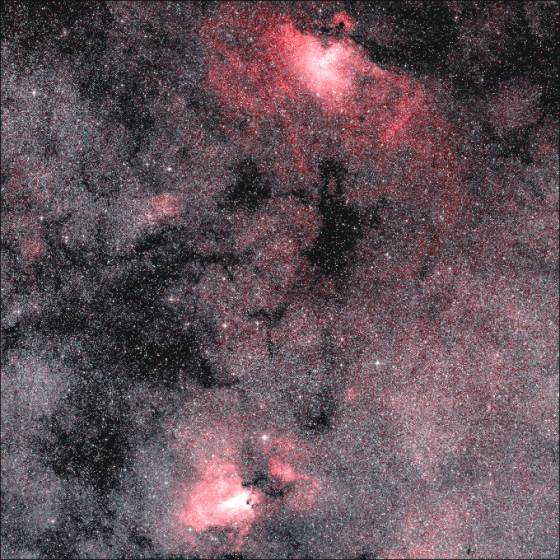
M16 and M17. Image size: 3.0°x3.0°. DSS image. © AAO/ROE
Ten degrees north of the Lagoon and Trifid nebulae lie another pair of famous nebulae. Known as the Eagle nebula (top) and Omega nebula (bottom), this picture shows these two nebulae against the background of the dense star fields of the Sagittarius Arm of the Galaxy. The numerous dark patches in this picture show that the Eagle and Omega nebulae are only the brightest areas in a region which also contains many dark nebulae.

This is a list of the nebulae in this region. The Eagle nebula (M16) is the largest of the two nebulae, although the name M16 (or NGC 6611) is often used only for the bright central region of the nebula and IC 4703 is used for the entire nebula. The Omega nebula (M17) is the other bright nebula here and it also includes IC 4706 and IC 4707. IC 4701 is also a fairly large (but much fainter) emission nebula in this region.
1 2 3 4 5 6 7 8
Catalogue Equatorial Galactic Size Type Distance Size Other Names
Number Coordinates Coordinates (arcmins) (ly) (ly)
RA (2000) Dec l° b°
--------------------------------------------------------------------------------------
IC 4701 18 16.0 -16 44 14.1 0.0 40' E 4250? 50?
IC 4703 18 18.6 -13 58 16.8 +0.8 60' E 5700 100
NGC 6611 18 18.8 -13 48 17.0 +0.8 8' E 5700 13 M16, Eagle nebula
IC 4706 18 19.7 -16 01 15.1 -0.4 4' E 4250 5
IC 4707 18 19.9 -16 00 15.2 -0.5 4' E 4250 5
NGC 6618 18 20.8 -16 11 15.1 -0.8 30' E 4250 40 M17, Omega nebula
IC 1287 18 30.4 -10 48 20.9 -0.3 20' R 4450? 25?
|
Column 1: The standard catalogue name for the nebula. Column 2: Right Ascension and Declination for epoch 2000. Column 3: Galactic Longitude (l) and Latitude (b). Column 4: Angular size of the nebula in arcminutes. Column 5: Nebula type: E = emission, R = reflection. Column 6: Approximate distance to the nebula. Column 7: Approximate size of the nebula in light years. Column 8: Alternative name of the nebula.
These are the star clusters which are perhaps most closely associated with the Eagle and Omega nebulae. Both nebulae contain star clusters at their centres (NGC 6611 and NGC 6618) which are responsible for causing the gas to glow.
1 2 3 4 5 6 7
Catalogue Equatorial Galactic Size Distance Age Other Names
Name Coordinates Coordinates (arcmins) (ly) (million
RA (2000) Dec l° b° years)
---------------------------------------------------------------------------------
Trumpler 32 18 17.5 -13 21 17.2 +1.3 5' 5600 300
NGC 6596 18 17.6 -16 39 14.3 -0.3 10' ? ?
NGC 6604 18 18.1 -12 15 18.2 +1.7 5' 5550 6
NGC 6611 18 18.9 -13 48 17.0 +0.8 6' 5700 8 M16
NGC 6613 18 20.0 -17 06 14.2 -1.0 5' 4250 17 M18
NGC 6618 18 20.8 -16 10 15.1 -0.7 25' 4250 1 M17
NGC 6631 18 27.2 -12 02 19.5 -0.2 6' ? ?
NGC 6645 18 32.7 -16 53 15.8 -3.6 14' ? ?
NGC 6649 18 33.5 -10 24 21.6 -0.8 5' 4450 37
|
Column 1: The standard catalogue name for the cluster.
Column 2: Right Ascension and Declination for epoch 2000.
Column 3: Galactic Longitude (l) and Latitude (b).
Column 4: Angular size of the cluster in arcminutes.
Column 5: Distance to the cluster.
Column 6: Approximate age of the cluster in millions of years.
Column 7: Alternative name of the cluster.
References: Dias W, Alessi B, Moitinho A, Lépine J, (2002). New catalogue of optically
visible open clusters and candidates. Astron and Astrophys, 389, 871.
This is a map of these two nebulae. The Eagle and Omega nebulae are two bright patches among many clouds of gas and dust which can be found all along the Sagittarius Arm.
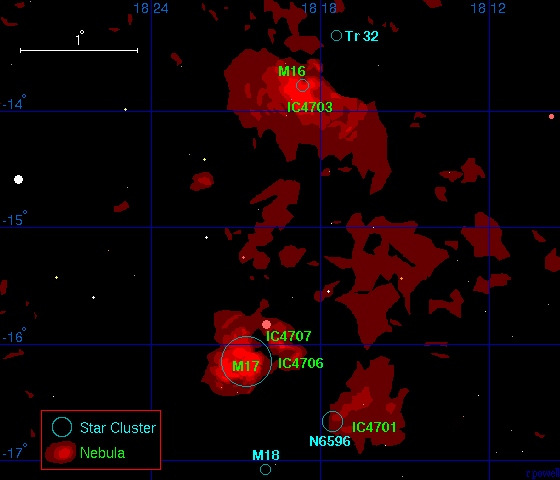
This is a picture of the Omega nebula - the nearest of the two nebulae. The Omega nebula is known to be situated at the northeast end of a huge (and dark) molecular cloud that stretches across several hundred light years. The stars in the cluster in the centre of the Omega nebula are very young with an average age of about 1 million years.
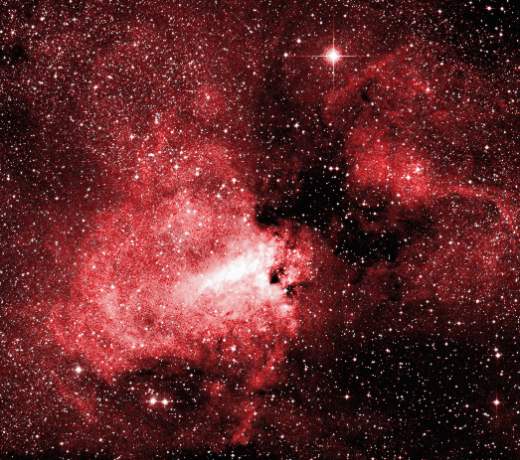

|
The Eagle and Omega nebulae are both in the Sagittarius Arm of the Galaxy. The Eagle nebula (M16) is the most distant of the two nebulae - it is about 5700 light years from us. The Omega nebula (M17) is about 4250 light years away and it is probably closer to the Lagoon nebula than to Eagle nebula. |
This is a picture of the Eagle nebula. The centre of this nebula is illuminated by a bright and compact cluster of stars with a diameter of about ten light years.

In April 1995, the Hubble Space Telescope took this picture of the centre of the Eagle nebula. It is one of the most famous pictures made by the Hubble Space Telescope. It revealed huge columns of hydrogen with a length of several light years. Many stars are forming inside these huge columns which are being blasted by intense radiation from many of the nearby stars. This picture was so stunning that it soon appeared everywhere. Publishers of astronomy books use this image a lot - they love to print it in books, posters and calendars even though there are many other superb Hubble Space Telescope pictures available.
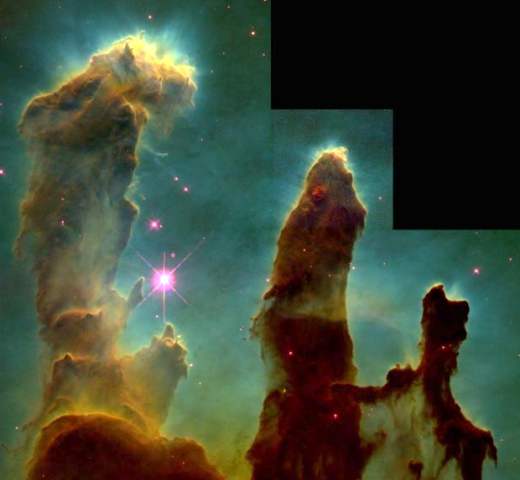
Few people realise however, that the colours in this image are not realistic. Hubble Space Telescope pictures of nebulae rarely use realistic colours. The colours are usually chosen to maximise the scientific value of the image. Below I have reconstructed this Eagle nebula picture using a realistic colour balance. This is much closer to what you would actually see if you could stand a few light years from the centre of Eagle nebula. Notice, for example, that the stars in this image are not pink but blue-white.
